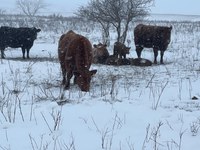Tips for Managing Cattle During Winter Conditions in April
(Click the image below to view a high-resolution image that can be downloaded)
The month of April 2022 will be recorded in history, and not favorably, at least in the short term. Areas of North Dakota experienced snowfall amounts that broke records, and the subsequent extended windy, cold weather with additional snow has produced great stress on newborn and young calves. North Dakota State University Extension veterinarian encourages farmers and ranchers to be observant of calf health challenges that may be brought on by the weather conditions.
“Calves that are chilled prior to nursing may need to be removed from the dam and provided external heat to reach normal body temperatures,” says Dr. Gerald Stokka, NDSU Extension veterinarian-livestock stewardship. “Providing colostrum from the dam or frozen colostrum or colostrum replacement products is critical to reduce the risk of illness and death in chilled newborn calves. In most cases where the calf has been removed, warmed and fed, and returned to the dam, the mother cow is able to recognize and re-bond to the calf.”
Dr. Stokka adds that managing the calving season this year requires the best of our efforts including diligence when observing calf behavior.
“Calves exhibiting normal behavior will nurse, nurse frequently, and along with the dam’s help, find areas out of the wind,” says Dr. Stokka. “Calves will demonstrate playful behavior such as running, jumping and sparring with other calves. Make sure calves off by themselves are observed. It is likely they may have been moved to a “safe space” by the mother and will be visited by the dam, nursed and moved again. However, calves off by themselves standing with a hunched pose need attention. Often just human presence will alert the dam to pay attention, sniff the calf and allow for nursing to take place.”
Dr. Stokka states that in the coming days and weeks, some calves may develop signs and symptoms of illness. The most common conditions diagnosed in the first three weeks of life are calf diarrhea or calf scours. These can be the result of infections with bacterial pathogens such as E. coli, viruses like rotavirus or coronavirus, or protozoa such as cryptosporidia.
He encourages farmers and ranchers to always be aware of potential human infections from cases of calf diarrhea and to take precautions to avoid the fecal-oral transmission. Wear plastic gloves, discard gloves between calves and make sure hand-washing is part of biosecurity. Be aware that when treating calves in pasture conditions, it is possible to transmit these organisms to pastures without cases of calf diarrhea.
“Other conditions may be observed, such as calves demonstrating some level of lameness,” says Dr. Stokka. “This can be the negative outcome of extreme chilling of newborn calves in which the extremities, ears and feet have been damaged. Calves can lose ears without long-term effects except for aesthetics, but damage to the feet will show up after approximately 7 to 10 days. The limbs above the foot may feel squishy or spongy. This condition is irreversible, and calves will need to be euthanized.”
“In addition, be aware of calves in the first week unwilling to stand and move, this may be due to umbilical infection,” says Dr. Stokka. “The umbilicus will be swollen and painful when pressure is applied. Antibiotics are necessary in these cases. Consult with your veterinarian to help with diagnosis and the proper use and selection of antibiotics.”
Dr. Stokka also stated that after three weeks of age, pneumonia may be noticed in calves. Calves will show depression and will have increased rectal temperatures (above 102.5 degrees F), and cows will not have been nursed. Consult with your veterinarian for the appropriate treatment. Coccidiosis, particularly in calves that were confined with their dams for the calving season, may become evident at this age. The incubation period for the coccidia is about three weeks. This means that calves which now may be out in pasture or in large areas were infected at an early age, and now are showing the clinical signs such as bloody diarrhea and in some cases depression and death. Again, consult with your veterinarian on treatment options.
“In addition to early-in-life risk, there may be long-term effects related to severe weather as well,” says Dr. Stokka. “When calves are compromised at birth and good immunity is not established, there remains a higher risk of illness and death loss even through the weaning phase.”
Dr. Stokka adds, remember, the sun will come up, the weather will improve and temperatures will become warmer. Do your best each and every day, do what you can, make sure you get rest and stay strong.
NDSU Agriculture Communication – April 21, 2022
Source: Dr. Gerald Stokka 701-231-5082, gerald.stokka@ndsu.edu
Editor: Kristin Harner, 701-231-7875, kristin.harner@ndsu.edu


